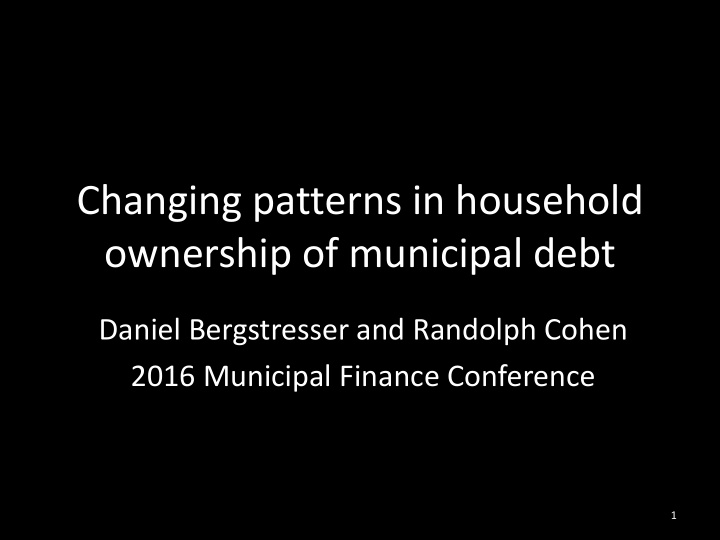



Changing patterns in household ownership of municipal debt Daniel Bergstresser and Randolph Cohen 2016 Municipal Finance Conference 1
Punchline Share of Households Owning Municipal Bonds, 1989-2013 6% 5% Any municipal debt 4% 3% Through mutual funds 2% 1% Direct ownership 0% 1988 1992 1996 2000 2004 2008 2012 2
Punchline Share of Municipal Bonds Held by Wealth Group, 1989- 2013 50% 45% 40% 35% Top 0.5 percent of financial assets 30% (excluding municipal bonds) 25% 20% Bottom 90 percent 15% 10% 5% 0% 1988 1992 1996 2000 2004 2008 2012 3
Municipal bond market • Sovereign repayment can be a mysterious thing (Bulow and Rogoff, 1989). Guembel and Sussman (2009) propose model where debt is held by voters of borrowing country. • Incidence of tax exemption is complicated (Galper et al (2014), but perceptions about who benefits are important. 4
Municipal bond market • Political economy matters for repayment of municipal debt and for continued existence of tax exemption. • Municipal bonds are disproportionately a retail-held investment. Household ownership of municipals is very direct. 5
Flow of Funds data • Munis: $3.65 trillion in total assets – $1.54 trillion held by household sector – $0.28 trillion by 2a-7 funds – $0.65 trillion by other mutual funds • Treasuries: $13.00 trillion in assets – $0.71 trillion held by households – $0.41 trillion by 2a-7 funds – $0.73 trillion by other mutual funds 6
Flow of Funds vs. SCF • Both conducted by Federal Reserve Board • Flow of Funds approach: count assets held by different reporting sectors (mutual funds, insurers) – households are a residual. Hedge funds turn out to be included with households • Survey of Consumer Finances – direct survey of a sample of households 7
Survey of Consumer Finances • Repeated cross section of a large number of households. Conducted by Federal Reserve Board and NORC. • Split-sample design with area-probability sample and list sample. Oversampling of households likely to be wealthy. 8
Survey of Consumer Finances • Survey repeated (with very stable set of questions) triennially since 1989. Most recent survey is 2013. • High response rates (Kennickell, 1999): 66 percent for area-probability sample in 1995; 13-44 percent for list sample (lower for higher wealth strata) 9
Survey of Consumer Finances • Response rates to individual questions is very high, although response rates to questions about municipal bonds are somewhat lower than some other questions. • Survey question non-response handled through multiple imputation. 10
Survey of Consumer Finances • 1989: 3,143 households surveyed • 2013: 6,015 households surveyed • Average financial assets: ~ $225k • Average financial assets of bottom 50% ~ 0 • Average financial assets of top 0.5% ~ $13M 11
Average holdings • Next slide shows average holdings, by year. • Average (inflation adjusted) is in neighborhood of $10k per household per year. • Average holdings in top 0.5 percent double between 1989 and 2013 12
13
Shares held by groups • Next slide shows shares held by different wealth groups, by year • Share held by top 0.5 percent rises from 23.8 percent in 1989 to 42.0 percent in 2013. 14
15
Shares held by groups • Can compare municipal concentration to other assets (wealth groups based on total financial assets). Top 0.5 share: • Municipals: 1989 – 45.4%; 2013 – 58.5% • Total Fin Assets: 1989 – 25.5%; 2013 – 28.7% • Stocks (outside TDA): 1989 – 38.9%; 2013 41.9% • All stocks: 1989 – 33.3%; 2013 – 30.8% 16
Share with positive holdings • Next slide shows shares with positive holdings, by year • Share holding munis falls from 4.6% in 1989 to 2.4% in 2013. 17
18
Comparing munis to other assets • Next slide shows change in ownership rates for a variety of different assets • Share holding other bonds (outside of TDAs) is falling dramatically, but offset by share holding fixed income assets inside of retirement accounts. 19
Direct holdings only • Direct holding category includes municipal bonds held through SMAs. Excludes bonds held through mutual funds. • Share holding munis falls from 3.5 percent to 0.9 percent. 20
Indirect holdings only • Indirect holding category includes only munis held through mutual funds. • Share holding munis rises from 1.5 percent to over 3 percent, then falls back to 1.6 percent. 21
Age of muni owners • Next slide compares age of muni owners to non-owning households. • Muni owners are older, but average age is rising more slowly than general population. 22
23
MTR of muni owners • Next slide compares marginal tax rates of municipal owners to other households. • MTRs of municipal-owning households are much higher than non-owning households. Median dollar held by household with 28% MTR. 24
25
26
Predicting muni ownership • We ran a probit model predicting municipal ownership in each year. • Share of assets held through TDA is important predictor (controlling for wealth and income) of whether household holds municipal bonds. 27
28
Summary • Static overall household ownership of municipal bonds masks an important trend: ownership concentrated in a smaller number of hands. • This matters due to political economy of market. • Explanation: Tax-deferred investing explosion. 29
Recommend
More recommend